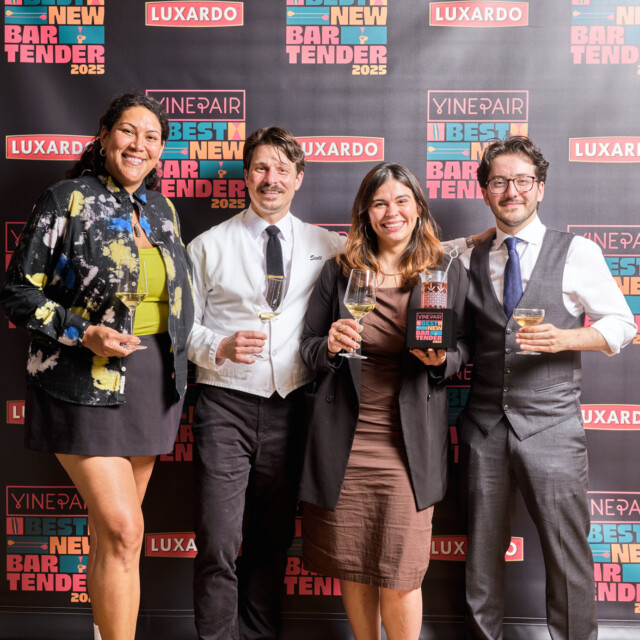Spirits spilled, blenders roared, shaker tins rattled, and when the dust settled, Daniela Pedraza of St. Louis’s New Society was crowned VinePair’s Best New Bartender of 2025.
The competition, sponsored by Luxardo, kicked off on March 3 when an online application period opened. After a few additional remote rounds, four finalists assembled at VinePair HQ in NYC on June 23 to face off for the title. The group included Pedraza, Linda Douglas of Los Angeles’s Donna’s, Samuel Fuller of NYC’s Eleven Madison Park, and Scott Kitsmiller of Gus’ Sip & Dip in Chicago.
All the contestants wowed the judges with their proprietary creations and ability to think creatively on their feet. Ultimately, Pedraza clinched the win with her presentation, unexpected flavor combinations, and reimagination of a beloved bar staple.
The day began with a bonus round in which the bartenders were tasked with creating a drink on the fly using Luxardo products, their choice of spirits from the VinePair bar, and anything they could find at the nearby Whole Foods. VinePair managing editor Tim McKirdy and director of strategy and innovation for Hotaling & Co., Elizabeth Staino, judged the bonus round.
Pedraza whipped up a White Negroni-inspired highball with gin, Bitter Bianco, vermouth, raspberry apricots, and grapefruit. Douglas hit the judges with a Sicilian-salad-inspired twist on Death & Co’s Joy Division cocktail, infused with dried mandarins, orange peel, and various herbs. Fuller shook up a tiki cocktail crafted with a blend of three rums, tahini-infused amaro, espresso liqueur, and a raspberry Demerara syrup. And Kitsmiller served an Espresso Martini and White Russian hybrid made with condensed coconut milk, Vietnamese instant coffee, and Luxardo Del Santo.
For the second round, the contestants made a pre-planned proprietary cocktail. These drinks were either originally created for their respective bars’ menus or crafted specifically for the competition. The finalists talked through their cocktails and prepared them for VinePair co-founders Adam Teeter and Joshua Malin and editor in chief Joanna Sciarrino.
After a meeting and tough deliberation, the judges announced Pedraza as VinePair’s inaugural Best New Bartender.
“Even competing at all was a surprise. Winning was just a cherry on top,” Pedraza says. “When I heard the announcement, I just kept thinking that I would not be here without the people who are with me.”
As is often the case, Pedraza’s first foray into bartending wasn’t preordained. Early on in her career in the health care business, her father unexpectedly passed away, so she took time off from her job and began reconsidering how she’d return to the working world. “I was in a position where I could not truthfully care for myself, but all of my life I knew how to care for other people,” she says. “I had been reading some bartending books over the summer and I was like, ‘I think that I could do this right now.’”
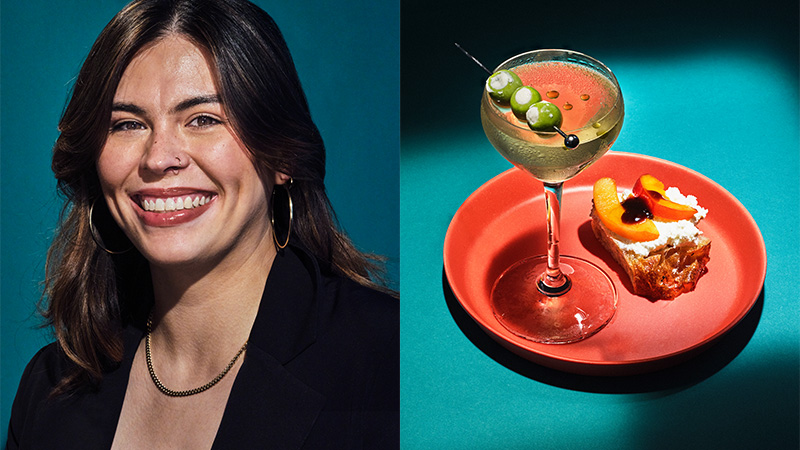
From there, Pedraza quickly cut her teeth in the industry. In November 2021, she landed a job at Avanzare, an Italian restaurant in Springfield, Mo., and worked there for six months before taking on the role of lead bartender at the vegetable-forward and seasonally focused Vicia in St. Louis. Not only did the new gig introduce her to the world of garden-style cocktails, but the restaurant’s high focus on hospitality pushed her to think about drink building and presentation through the lens of her guests. “I was caring for people that I didn’t even know before I was caring about myself,” she says. “And I’m really proud of myself for doing that.”
“I live for the moment when curiosity takes over a guest — when I start explaining a clarified Milk Punch or the story behind a foraged syrup and suddenly their eyes light up. Those moments of connection, especially when I’m working farm-to-glass-style, remind me why I do this.”
The farm-to-glass ethos became a big part of Pedraza’s approach to making cocktails, stemming not only from her experience at Vicia, but also her upbringing. “I’m Mexican, and I grew up eating a lot of fresh fruits, so a lot of really bright ingredients are in my wheelhouse,” she says. “I find that I take that part of my childhood, combine it with cocktail and flavor theory, and put it all together.“
After honing her skill set at Vicia, Pedraza made the leap to her most recent position as bar manager of St. Louis’s speakeasy-style New Society, where experimentation and modern techniques take center stage. The experience has allowed Pedraza to elevate her skills without venturing too deep into esoteric territory. Her drinks walk the tightrope between approachability and introducing guests to something they’ve likely never encountered before.
“I live for the moment when curiosity takes over a guest — when I start explaining a clarified Milk Punch or the story behind a foraged syrup and suddenly their eyes light up,” she says. “Those moments of connection, especially when I’m working farm-to-glass-style, remind me why I do this. Education is never a lecture. It’s a shared spark.”
Pedraza’s final round drink was a take on a Dirty Martini called The Root. Inspired by a chorizo-fat-washed cocktail from the Vicia menu, she decided to replicate the drink’s flavor profile but with vegetables in place of meat. To mimic the smokiness of the chorizo, she infused gin with smoked celery root, before adding citrus vodka, aloe liqueur, dry vermouth, and olive brine to achieve balance and maintain the essence of a Dirty Martini at the cocktail’s core. “I saw an opportunity to create something just as bold and satisfying, but accessible,” she says.
Each of the other finalists arrived with their own tricks up their sleeves. Their drinks were not only delicious, but emblematic of their respective careers, showcasing personality and unique approaches to crafting cocktails.
“Those often treated as disposable are in fact the foundation of our communities. I saw no better way to get the story across of what is happening in our industry right now than to use my privilege here today.”
“I grew up playing jazz music, and I’ve always had the mindset of looking at cocktails through the lens of music,” Scott Kitsmiller says. As he explains, his approach stems from mastering the classics — like how music theory becomes second nature for a jazz artist — and then using those templates as a jumping-off point for improvisation. At Chicago’s Gus’ Sip & Dip, where he is the bar manager, the menu consists exclusively of classic cocktails. And while Kitsmiller’s creation for the competition was based on the Champagne Cocktail, he turned the drink on its head.
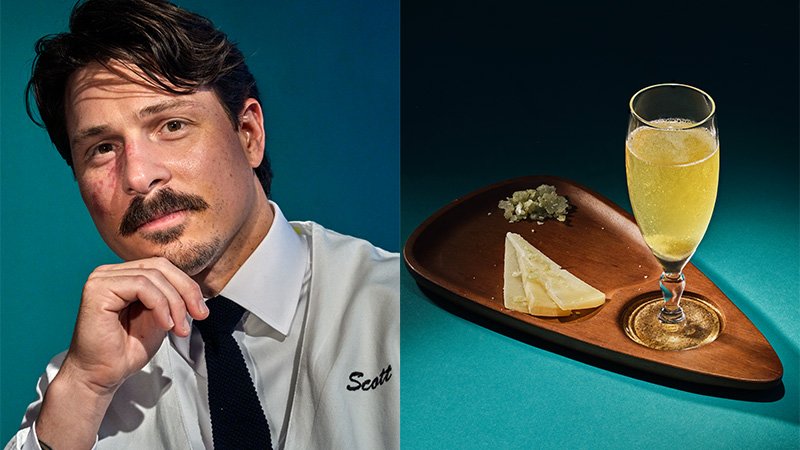
Dubbed the Prince of Rodney Bay, it featured a force-carbonated blend of clarified apple juice, Cognac, and rum poured over a Green Chartreuse sugar cube soaked in Chartreuse Elixir Végétal. “The Champagne Cocktail is such a simple drink at its core,” Kitsmiller says. “So the idea of taking each ingredient and turning them into something thought-provoking but still tasty was really exciting to me.”
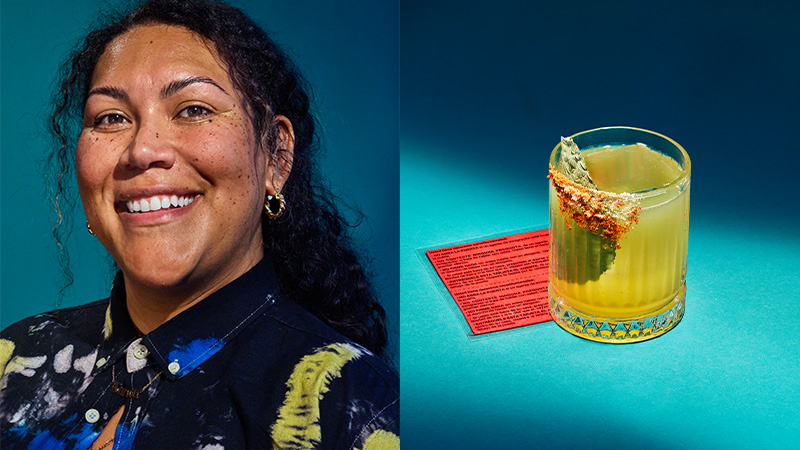
L.A.-based finalist Linda Douglas’s drink-making philosophy is rooted in nostalgia, approachability, and education without intimidation, but she also strives to make her position in hospitality a platform for cultural advocacy. “The people that were historically pushed to the side and overlooked have always been here, but now we are the new leaders, defending our culture and space,” she says.
To honor Mexican immigrants and how their culture is woven into the fabric of America’s food and beverage industry, Douglas presented a cocktail called No Kings, crafted with Mexican corn whisky, elote and chile pasilla mixe liqueurs, lime juice, and myriad Latin herbs. “Those often treated as disposable are in fact the foundation of our communities,” she says. “I saw no better way to get the story across of what is happening in our industry right now than to use my privilege here today.”
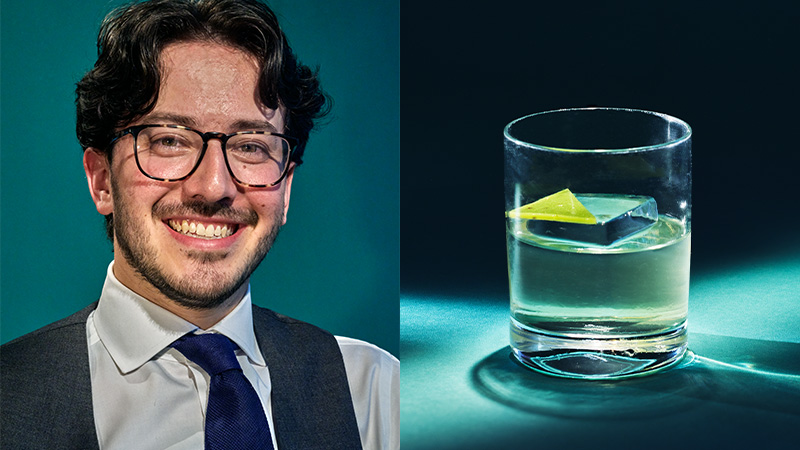
Eleven Madison Park’s Sam Fuller takes a science- and ingredient-driven approach to crafting cocktails, incorporating new techniques whenever possible. “I love going to other bars, trying a drink that just blows me away, and hearing about the process behind it,” he says. “I’ve always wanted to work at a place that introduced me to some cutting-edge techniques.”
Techniques aside, Fuller often begins with a single ingredient. For his final-round cocktail, kiwi was the star of the show. Built on a base of shochu and Scotch, his drink — named Shiso — included kiwi jelly, acidified kiwi juice, a shiso cordial, and pecan orgeat, among a handful of other ingredients. “When I’m working on a drink, it starts off as this huge jumble of ideas, and I chip away at it until it’s more refined, everything makes sense, and everything has a purpose.”
Every time it seems like cocktail innovation has hit its ceiling, a drink or two comes around and reminds us that bartenders around the country are breaking new ground every day. And in an industry overflowing with talent and creativity, some stars fly under the radar. That spurred VinePair to host our inaugural Best New Bartender competition, and shine a light on the up-and-coming professionals who are making serious waves in their respective cities and the industry at large.
“My wish for the future of bartending would be that bartenders continue supporting each other through mutual promotion and the competitive aspect of our careers — not in the sense that we are competing with one another, but more that we’re collaborating with one another,” Pedraza says. “The brands that we work with provide a lot of value to our work, and they can help us move with more ease throughout the world, but we can also do that for each other and with each other to be truly successful.”
This story is a part of VP Pro, our free platform and newsletter for drinks industry professionals, covering wine, beer, liquor, and beyond. Sign up for VP Pro now!
